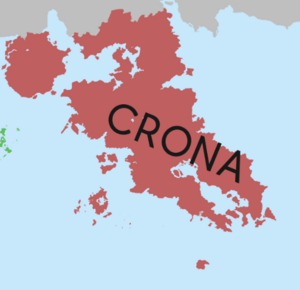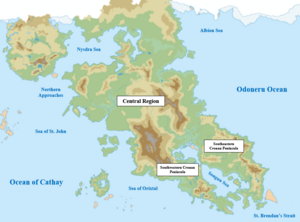Crona
This article is a work-in-progress because it is incomplete and pending further input from an author. Note: The contents of this article are not considered canonical and may be inaccurate. Please comment on this article's talk page to share your input, comments and questions. |
This article or section is out of date because it is either legacy lore from a participant who is no longer here or because it has been rendered obsolete by new lore. Note: To contribute to this article, you may need to seek help from the author(s) of this page. |
 | |
| Area | 999,999 km2 (386,102 sq mi) |
|---|---|
| Population | wip |
| Population density | wip |
| Demonym | Cronan Cronite |
| Dependencies | Most |
| Languages | Alstinian Ænglish,Hieratic Varshani, Coscivian, others |
| Largest cities | Largest urban areas: Taisgol Alstin Anzo Farpoint Kurst |
Crona is a continent.
To the Occidental civilization, it was first extensively explored and charted by Paul Aster in his 1387 expedition.
Name
Extent
Regions
Greater Nysdra Region
The Greater Nysdra region is Most economists and scholars believe the level of poverty and lack of developed economies in the Greater Nysdra region are a result of historic hegemony by Varshan, who extracted significant amount of both tribute and slaves from its neighbors during the second millennia AD. The lack of wealth and viable agricultural manpower lead to severe economic degradation in most of countries in the region while enhancing Varshan's economy, allowing it to construct modern weapons and import Occidental novelties for its ruling classes.

Central region
Songun Region
The Songun Region, also referred to as South Crona, comprises the nations located in the Southeastern and Southwestern Cronan Peninsulas, as well as the Alstinian Isles. South Crona possesses the most economically prosperous nations in Crona, largely owing to the Occidental settlement that occurred in this region from the 15th to 20th centuries.
Countries, dependencies, and other territories
| Rank | Country (or dependent territory) | Population (2025) | Area in km2 (sq mi) | Density in per/km2 (per/sq mi) |
|---|---|---|---|---|
| 1 | Anta Carda | 36,990,780 | 418,826.95 (161,709.99) | 88.32 (34.10) |
| 2 | Arctic Tribal Lands | 8,350,305 | 3,630,567.47 (1,401,769.94) | 3.2 (1.2) |
| 3 | Ceylonia | 34,866,975 | 892,458 (344,580) | 39.06 (15.08) |
| 4 | Eastern Reaches | 136,604,240 | 1,227,498.91 (473,939.98) | 111.28 (42.97) |
| 5 | Ehemo | 93,540,365 | 1,007,298.13 (388,919.98) | 92.86 (35.85) |
| 6 | Galicia | 18,529,217 | 727,528 (280,900) | 25.46 (9.83) |
| 7 | Hikara | 51,378,475 | 671,350.78 (259,209.99) | 76.53 (29.55) |
| 8 | Kelekona | 73,465,525 | 1,258,604.66 (485,949.98) | 58.37 (22.54) |
| 9 | Northern Confederation | 51,075,840 | 2,170,668.94 (838,099.96) | 23.53 (9.08) |
| 10 | Pankara | 150,879,635 | 982,278.84 (379,259.98) | 153.60 (59.31) |
| 11 | Porlos | 6,808,983 | 219,786.38 (84,860.00) | 30.98 (11.96) |
| 12 | Punthite Republic | 141,226,570 | 1,062,413.07 (410,199.98) | 132.93 (51.32) |
| 13 | Sabnaki | 7,711,800 | 343,510.10 (132,629.99) | 22.45 (8.67) |
| 14 | Southern Tribes | 30,984,340 | 1,340,733.18 (517,659.97) | 23.11 (8.92) |
| 15 | Telonaticolan | 39,320,050 | 1,382,561.49 (533,809.98) | 28.44 (10.98) |
| 16 | Ulaga | 2,707,330 | 145,790.42 (56,290.00) | 18.57 (7.17) |
| 17 | Varshan | 752,144,212 | 7,931,165.00 (3,062,239.93) | 94.83 (36.61) |
| 18 | Walawaku | 5,136,785 | 524,161.77 (202,379.99) | 9.8 (3.8) |
| 19 | Western Federation | 35,716,390 | 2,889,675.51 (1,115,709.95) | 12.36 (4.77) |
| 20 | West Punth Territories | 26,506,045 | 1,456,376.15 (562,309.98) | 18.20 (7.03) |
| 21 | Wild Lands | 3,532,570 | 483,913.35 (186,839.99) | 7.3 (2.8) |
| 22 | Tierrador | 101,604,230 | 2,041,817.78 (788,350.99) | 49.76 (122.88) |
| 22 | Zospiyjan |
History
Natural history
Prehistory and early history
Growth of civilization
Occidental exposure and Varshani growth
Relative decline of Anzo and globalization
The Deluge
Post-Deluge
Nysdrine mediatization
Many states established in Cusinaut during the Deluge were created out of fear of another country or in defense against that country for its inhabitants, such as the Unnuaq Mission State's relationship with Algoquona. However, as the Deluge ended and foreign ascendancy in north Crona was confirmed, the necessity of these so-called "reactive states" and territories was significantly reduced. Accordingly, beginning in 2030, a process of state and territorial consolidation began known as the "Nysdrine mediatization". The process began with the establishment of Housatonic as an independent republic and its joining to the Unnuaq Chain. Following that, the former Unnuaq Mission State was annexed to New Harren as a formal mission protectorate state was no longer needed. After the Pachoy Rebellion, the former charter city of Pachaug was incorporated into the Chenango Confederacy.